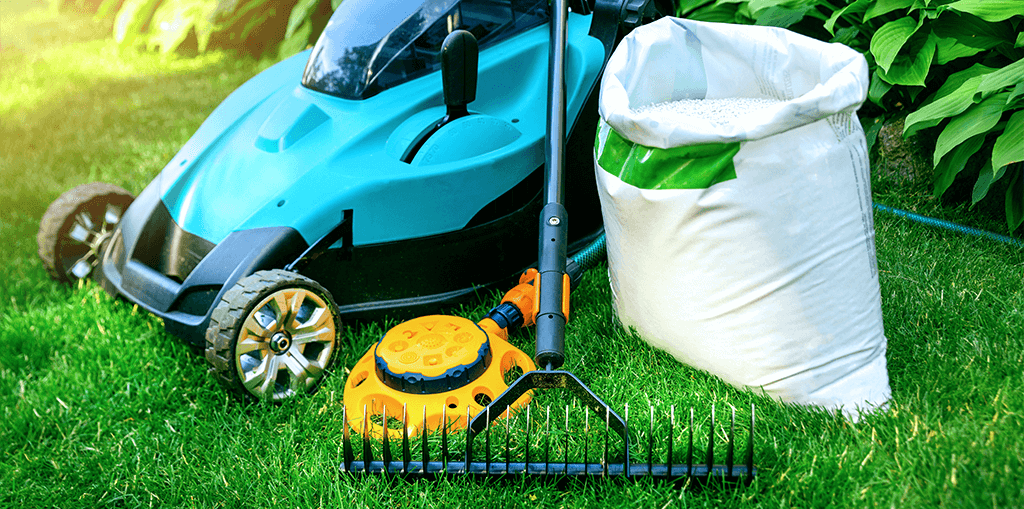Lawn Care in Spring: Revitalize Your Yard for the Season Ahead

Introduction:
As the winter chill begins to fade and the days
grow longer, homeoners everywhere turn their attention to their outdoor
spaces, eager to breathe new life into their lawns and gardens. Spring is the
perfect time to revitalize your yard after the dormant winter months, and
proper lawn care is essential for achieving a lush, healthy lawn that you can enjoy
all season long. In this comprehensive guide, we'll explore everything you need
to know about lawn care in spring, from essential tasks to helpful tips and
tricks for achieving a vibrant and thriving lawn.
Understanding Spring Lawn Care
Spring is a critical time for
lawn care, as it sets the foundation for a healthy and vibrant lawn throughout
the rest of the year. As temperatures begin to rise and grass starts to grow
again, there are several key tasks that homeowners should prioritize to ensure
their lawn thrives during the spring months.
Raking and Dethatching:
After a long winter, your lawn may be
littered with debris such as leaves, twigs, and other organic matter. Raking
your lawn helps to remove this debris, allowing sunlight, air, and water to penetrate
the soil and reach the grass roots. Additionally, sping is an ideal time to
dethatch your lawn if necessary. Thatch is a layer of dead grass and organic
material that can build up on the surface of your lawn, inhibiting water and
nutrient absorption. Dethatching removes this layer, promoting healthy grass
growth.
Aeration:
Over time, soil can become compacted, making it
difficult for grass roots to access air, water, and nutrients. Aerating your
lawn helps to alleviate soil compaction by creating small holes in the soil,
allowing air, water, and nutrients to reach the grass roots more effectively.
Spring is an excellent time to aerate your lawn, as the grass is actively
growing and can quickly recover from the aeration process.
Overseeding:
Overseeding is the process of spreading grass
seed over your existing lawn to fill in thin or bare patches and promote thick,
lush growth. Spring is an ideal time for overseeding, as the warmer
temperatures and increased moisture create optimal conditions for seed
germination and grass growth. Before overseeding, be sure to prepare the soil
by raking away debris and aerating if necessary. After overseedin, keep the
soil consistently moist to promote seed germination and establishment.
Fertilization:
Spring is also a crucial time for fertilizing
your lawn, as grass begins to actively grow and requires additional nutrients
to support healthy growth. Choose a high-quality fertilizer specifically
formulated for spring application, and apply it according to the manufacturer's
instructions. Avoid over-fertilizing, as this can lead to excessive top growth
and weaken the grass roots.
Weed Control:
Spring is prime time for weeds to emerge and
compete with your grass for space, water, and nutrients. Implementing a
proactive weed control strategy in the spring can help prevent weeds from
taking over your lawn. Consider using pre-emergent herbicides to prevent weed
seeds from germinating, as well as post-emergent herbicides to target existing
weeds. Be sure to follow the application instructions carefully and avoid
applying herbicides on windy days to prevent drift.
Watering:
Proper watering is essential for maintaining a
healthy lawn in spring. As temperatures rise and rainfall becomes less
consistent, it's important to ensure your lawn receives an adequate amount of
water to support healthy growth. Water deeply and infrequently, aiming for
about 1 inch of water per week, including rainfall. Water your lawn early in
the morning to minimize evaporation and reduce the risk of fungal diseases.
Mowing:
As your grass begins to grow more rapidly in the
spring, regular mowing becomes essential to maintain a neat and tidy
appearance. Set your mower blades to the appropriate height for your grass type
and mow frequently enough to remove no more than one-third of the grass blade
at a time. Keeping your grass at the proper height helps promote healthy root
growth and prevents scalping, which can weaken the grass and make it more
susceptible to stress and disease.
Pest Control:
Spring is also a critical time for pest control
in the lawn. Keep an eye out for signs of pests such as grubs, cinch bugs, and
armyworms, and take proactive measures to prevent infestations. Consider using
environmentally friendly pest control methods such as beneficial nematodes or
insecticidal soaps to target specific pests while minimizing harm to beneficial
insects and wildlife.

Choosing the Right Lawn Care Products and Equipment
When it
comes to caring for your lawn in spring, choosing the right products and equipment
is essential for achieving optimal results. Here are some tips for selecting
the best lawn care products and equipment for your needs:
Choose High-Quality Fertilizers:
When selecting a fertilizer
for your lawn, choose a high-quality product specifically formulated for spring
application. Look for fertilizers with a balanced ratio of nitrogen,
phosphorus, and potassium (N-P-K) to support healthy grass growth. Consider
using slow-release fertilizers, which provide a steady supply of nutrients to
your lawn over time and reduce the risk of nutrient runoff.
Invest in Quality Lawn Tools:
Investing in high-quality lawn tools and equipment can make a sigificant difference in the effectiveness and efficiency of your lawn care routine. Choose durable tools such as rakes, aerators, and spreaders that are designed to withstand regular use and provide consistent results. Consider investing in electric or battery-powered lawn tools for added convenience and ease of use.
Consider Organic Lawn Care Products:
If you prefer to take a
more natural approach to lawn care, consider using organic lawn care products
that are free from synthetic chemicals and pesticides. Organic fertilizers,
compost, and natural pest control methods can help promote healthy soil and a
thriving lawn while minimizing harm to the environment and beneficial
organisms.
Read and Follow Label Instructions:
When using lawn care
products such as fertilizers, herbicides, and insecticides, it's essential to
read and follow the label instructions carefully. Pay attention to application
rates, timing, and safety precautions to ensure the effective and responsible
use of these products. Avoid applying lawn care products on windy days or
before rainfall to prevent runoff and minimize environmental impact.
Conclusion:
Spring is a critical time for lawn care, as it
sets the stage for a healthy and vibrant lawn throughout the rest of the year.
By following the essential lawn care tasks outlined in this guide and investing
in the right products and equipment, yu can achieve a lush, green lawn that
you can enjoy all season long. Whether you're raking away debris, aerating the
soil, or fertilizing new growth, taking proactive steps to care for your lawn
in spring will pay off with a beautiful and thriving outdoor space that you can
be proud of. With the right knowledge and a little elbow grease, you can
transform your yard into a lush and inviting oasis that you'll love spending
time in with family and friends.









